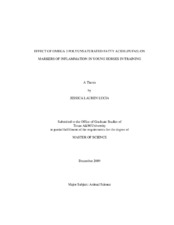| dc.description.abstract | Sixteen horses (2 to 4 yr; 357 to 439 kg BW) were utilized in a randomized complete block design for a 140 d trial to determine effect of omega 3 PUFAs (n-3) supplementation on markers of inflammation in young horses in training. Horses were fed treatments consisting of a control diet (n = 8) fed at 1% BW (as fed) or a treatment diet (n = 8) of concentrate fed at 0.75% BW (as fed) and 350 g of a marine n-3 supplement formulated to provide 15 g of eicosapentaenoic acid (EPA) and 20 g of docosahexaenoic acid (DHA). Body weight and body condition scores (BCS) were obtained biweekly and concentrate adjusted accordingly.
Horses were exercised 5 d/wk by students in an equine training course. Type of activity and duration was monitored, along with heart rate to quantify workload. Exercise protocol was divided into 2 phases: phase I (d 0 to110) consisted of ground work and early training under saddle, and phase II (d 111 to 140) consisted of advance maneuvers and moderate workload.
Synovial fluid was obtained from right radial carpal joint by arthrocentesis every 28 d and was analyzed for white blood cell count (WBC), total protein (TP), and specific gravity (SG). Serum concentrations of carboxypeptide type II collagen (CPII) and chondroitin sulfate 846 (CS-846) were analyzed by ELISA kits. Dietary treatment did not affect synovial WBC, TP, or SG. Also, concentrations of WBC and TP also did not differ over time. SG increased over time (P < 0.001) as horses moved from phase I to phase II of the trial. Dietary treatment did not influence concentrations of CPII or CS-846. CS-846 tended to increase over time (P = 0.09) and CPII concentrations also increased (P < 0.001) in response to changes in exercise. Furthermore, all horses gained BW and BCS throughout the trial (P < 0.001), but values were not influenced by treatment. This data indicates further studies are needed to determine the efficacy of n-3 supplementation as a preventative measure against development of osteoarthritis. | en |


